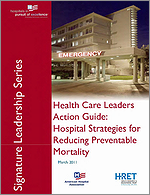A Health Care Leader Action Guide: Hospital Strategies for Reducing Preventable Mortality
 Why Is Focusing On Preventable Mortality Important?
Why Is Focusing On Preventable Mortality Important?
Hospital leaders work hard every day to provide high quality care to the patients that they treat. They do this with the goal of providing care that is free of injury and harm. Nonetheless, much has been written about the numbers of patients that die unnecessarily in our nation's hospitals. The publication of the 1999 landmark Institute of Medicine report, To Err is Human: Building a Safer Health System, brought attention to this problem with the estimation that between 48,000 and 98,000 deaths from medical errors occur each year in U.S. hospitals.
Since then, much attention has been focused on ways to improve quality and patient safety. While most hospital deaths are not due to failures in care delivery, many deaths are preventable and this presents an important opportunity for hospital leaders to address. By collectively pursuing improvement strategies in a visible and measurable way, hospitals will be joining forces to advance a health care system that delivers the right care, to the right patient, in the right place. Hospital mortality is also an issue that easily resonates with the public. Demonstrable improvement in this area will go a long way towards maintaining and strengthening public confidence in our nation's hospitals.
There is also a slide deck associated with this report.

